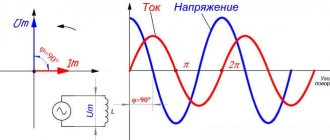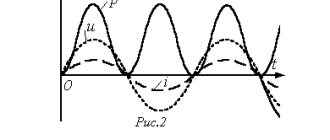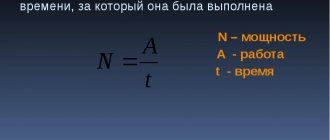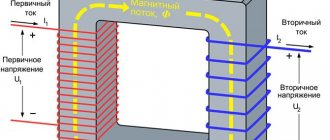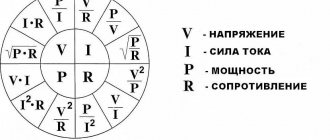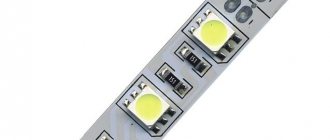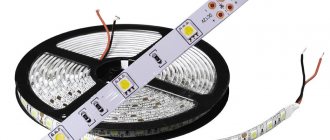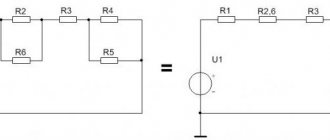The frequency of the electric current is one of the power quality parameters and the main characteristic of the power system mode. Quantitatively, the frequency in the power grid is equal to the number of periods per second. Changing the frequency in the network affects the functioning and, accordingly, the performance of consumers. Frequency deviation also has an impact on the operation of the entire power system.
Standardized requirements for indicators
In the Russian Federation, requirements for the quality of power system operation are standardized.
In accordance with GOST 13109-97, the frequency in the power system must be continuously maintained at the level f = 50 ± 0.2 Hz, while a short-term frequency deviation up to ∆f = 0.4 Hz is allowed.
Analyzing the dependence of current on frequency, we can conclude that if the connected load is purely active in nature (for example, a resistor), then over a wide range the current will not have a dependence on frequency. In the case of sufficiently high frequencies, when the inductance and capacitance of the connected load are characterized by a resistance comparable to the active one, the current strength will have a certain dependence on frequency.
In other words, when the frequency of the current varies, a change in capacitance occurs, a change in which, in turn, leads to a change in the current flowing through the circuit.
That is, as the frequency increases, the capacitance decreases and the current flowing through the circuit increases.
The mathematical expression of the dependence will have the following form: I = UCω;
The dependence, taking into account active resistance, will be determined by the following expression: I (ω) = UCω √(R2 • C2 • ω2 + 1).
The influence of current frequency on electrical appliances
Next, we consider the influence of the frequency of electric current. An increase in frequency to relatively low values (1 - 10 thousand Hz) is usually a consequence solely of an increase in the rated power of electrical equipment, since this increases the conductivity of the gas gaps. Frequency meters are used to measure frequency in the system.
A steam turbine is designed and built in such a way that at rated rotation speed (frequency) it provides maximum shaft power output. In this case, a decrease in the nominal frequency is a consequence of the occurrence of losses due to the impact of steam on the blades with a simultaneous increase in the torque, and an increase in frequency leads to a decrease in the torque.
Thus, the most economical operating mode is achieved at the optimal frequency.
In addition, operation at lower frequencies leads to accelerated wear of the rotor blades and other parts and mechanisms. A decrease in frequency affects the station's own consumption.
Power is what characterizes the speed of transmission with the conversion of electricity. What are the power standards in the AC network and types, what are active and reactive power? More on this and more below.
Power standards in the AC network
Voltage and power are what every person living in an apartment or private house needs to know. The standard AC voltage in an apartment and a private house is expressed as 220 and 380 watts. As for determining the quantitative measure of the strength of electrical energy, it is necessary to add the electric current with the voltage or measure the required indicator with a wattmeter. At the same time, in order to take measurements with the last device, you need to use probes and special programs.
AC power is determined by the relationship of the amount of current with time, which produces work in a certain time. An ordinary user uses the power indicator transmitted to him by the electrical energy supplier. As a rule, it is equal to 5-12 kilowatts. These figures are enough to ensure the functionality of the necessary household electrical equipment.
This indicator depends on the external conditions for the supply of energy to the house, what current-limiting devices are installed (automatic or semi-automatic) that regulate the moment the power tanks enter the consumer source. This occurs at different levels, from the household electrical panel to the central electrical distribution unit.
Characteristics
Alternating current flows through a circuit and changes its direction with magnitude. Creates a magnetic field. Therefore, it is often called periodic sinusoidal alternating electric current. According to the law of a curved line, its value changes after a specific period of time. That's why it's called sinusoidal. Has its own parameters. The important ones are to indicate the period with frequency, amplitude and instantaneous value.
A period is the time during which the electric current changes, and then it repeats again. Frequency is the period per second. Measured in hertz, kilohertz and millihertz.
Amplitude is the maximum current value with voltage and flow efficiency over a full period. Instantaneous value is an alternating current or voltage that occurs during a specific time.
Current sinusoidality
If you connect a resistor (for example, a light bulb or a heater) to an outlet, the circuit will close and current will flow through it. We understand that the higher the voltage (water pressure), the higher the current will be (according to Ohm's law, I = U / R)
. And since the voltage changes in a sinusoid, the current will also change in a sinusoid, synchronously with the voltage.
Since the voltage is variable, the current will also be variable. At first it flows in one direction, and when the voltage changes its sign, the current flows in the other direction. That is, the current in the wires constantly jerks in different directions. However, these are already details. It is enough for us to understand that the sinusoid of voltage change
completely naturally synchronous in time with the sinusoid of changes in
current
Graph from the article https://www.sxemotehnika.ru/zakon-oma-dlia-peremennogo-toka.html
Types of capacities
Power is a measured physical quantity that is equal to the rate of change with the conversion, transmission or consumption of system energy. According to a narrower concept, this is an indicator that is equal to the ratio of time spent on work to the period itself spent on work. In mechanics it is designated by the symbol N. In electrical engineering the letter P is used. You can often also see the symbol W, from the word watt.
AC power is the product of current, voltage and cosine of the phase shift. In this case, only the active and reactive varieties can be easily counted. You can find out the full power value through the vector dependence of these indicators and area.
Active power
Active is called useful force, which determines the process of direct conversion of electricity into the required type of force. In each electrical appliance it is transformed in its own way. For example, a light bulb produces light with heat, an iron produces heat, and an electric motor produces mechanical energy. Accordingly, it shows the efficiency of the device.
How to calculate the number and power of transformers.
The specific load density of transformers is determined by the calculated total power Sp and the area of the object F, namely σ = Sp/F
Threshold values of the rated power of transformers Sн are established based on the specific load density, taking into account the fact that:
- at σ ˂ 0.2 kVA/m², transformers with a power of up to 1000 kVA are appropriate;
- at σ ˂ 0.2-0.3 kVA/m², transformers with a capacity of 1600 kVA are appropriate;
- at σ > 0.3 kVA/m², transformers with a capacity of 1600 kVA or 2500 kVA are appropriate.
Table.
Recommended rated power of the transformer at different specific load densities.
| Specific load density σ | kVA | 0,05 | 0,08-0,14 | 0,15-0,2 | 0,21-0,3 | 0,3-0,35 |
| Rated power Snt | kVA | 400 | 630 | 1000 | 1600 | 2500 |
Find the number of transformers (rounded towards a larger integer value) Nt = Pmax/(Kz*Snt), where Kz is the load factor of the transformer, which is taken equal to:
- Kz = 0.65-0.7 with a predominance of category I loads for a two-transformer substation;
- Kz = 0.7-0.8 with a predominance of category II loads for single-transformer transformer substations and mutual redundancy on the low voltage side;
- Kz = 0.9-0.95 with loads of category II and the presence of a warehouse reserve, as well as with the predominance of loads of category III.
How to find out what power is in an AC circuit
It is worth pointing out that this is a value that is directly related to other indicators. For example, it is directly dependent on time, force, speed, vector of force and speed, modulus of force and speed, moment of force and speed of rotation. Often in formulas when calculating electrical power, the number Pi is also used with the resistance indicator, instantaneous current, voltage in a specific section of the electrical network, active, total and reactive power. Direct participants in the calculation are the amplitude, angular velocity and initial current strength with voltage.
In a single-phase circuit
You can understand what power indicator is in a single-phase alternating current circuit by using a current transformer. To do this, you need to use a wattmeter, which is connected through a current transformer. The readings should be multiplied by the transformer current coefficient. When measuring power at high voltage, a current transformer is needed to insulate the wattmeter and ensure the safety of the user. The parallel circuit is not connected directly, but thanks to a voltage transformer. Secondary windings with housings of measuring transformer installations must be grounded to avoid accidental insulation damage and high voltage contact with devices.
Note! To determine the parameters in the network, it is necessary to multiply the ammeter by the transformer current coefficient, and multiply the numbers obtained by the voltmeter by the transformer voltage coefficient.
In a three-phase circuit
In an alternating current circuit, the power indicator in a three-phase circuit can be determined by multiplying the current by the voltage. Since this is not a constant electric current, it depends on time and other parameters, so it is necessary to use other proven circuits. So, you can use a wattmeter.
The measurement must be carried out in only one phase and multiplied by three according to the formula. This method saves equipment and reduces measurement dimensions. Used for high precision measurement of each phase. In case of an asymmetrical load, you need to use the appropriate wattmeter connection diagram. This is a more accurate method, but requires three wattmeters.
Note! If the circuit does not provide for the presence of a neutral conductor, an appropriate circuit is also needed.
It is worth pointing out that today it is possible to measure the necessary indicators not only with an analogue, but also with a digital device. The difference between the second one is its reduced size and lightness. In addition, digital units have ways to record current with voltage, network cosine, and others. This makes it possible to monitor various quantities from a distance and transmit warnings if there is a deviation. This is convenient because you don’t need to measure current with voltage, and then, using formulas, calculate everything thoroughly.
In general, power is a quantity whose main purpose is to show the strength of a particular device and, in many cases, the speed of activity interacting with it. It can be mechanical, electrical, hydraulic and for direct current and alternating current. Measured according to the international system in watts and kilowatts.
Energy savings and precise system control are the main reasons for using frequency converters in HVAC (Heating, Ventilation and Air Conditioning) systems . Energy conservation is important because a small reduction in the speed of a fan or centrifugal pump has a very large impact on its energy consumption.
The efficiency of fans or pumps together with the frequency converter remains high at lower speeds. Engine efficiency, however, decreases as the engine becomes underutilized. Variable speed drive manufacturers have attempted to improve the low speed efficiency of motors using a number of design solutions. Unfortunately, most of these solutions require laborious manual adjustments and still fail to optimize engine efficiency under all conditions.
The VLT HVAC Drive has a unique control function called Automatic Energy Optimization (AEO). With this function, the frequency converter automatically increases the motor efficiency to the maximum in all operating conditions.
The reason for reduced motor efficiency at light loads and how AEO counteracts this natural tendency is discussed below. The uses and limitations of this feature are also discussed.
How to calculate correctly
Active power, how to make the correct calculation?
The power of the electric current affects how quickly the device can complete the job. For example, an expensive heater with twice the power will heat a room faster than two cheap ones with half the power. It turns out that it is more profitable to buy a unit with more power in order to heat a cold room faster. But, at the same time, such a unit will consume significantly more energy than its cheaper counterpart.
The power consumption of all appliances in the house is also taken into account when selecting wiring for installation in the house. If you do not take this into account and subsequently connect too many devices to the network, this will cause network overload. The wiring will not be able to withstand the power of the electric current of all devices, which will lead to melting of the insulation, short circuit and self-ignition of the wiring. As a result, a fire may start, which can lead to irreparable consequences.
Single-phase sinusoidal current in electrical circuits is calculated by the formula P = U x I x cos φ, where υ and Ι. Their designation is encrypted as follows: the root mean square value of voltage and current, and φ is the phase angle between them.
For non-sinusoidal current circuits, the electrical capacitance is equal to the square root of the sum of the squares of the active and reactive performance. Active performance is characterized by the speed of the irreversible process of converting electrical energy into other types of energy. This capacitance can be calculated through the current, voltage and active component of the circuit resistance r or its conductivity g using the formula P = I(2) xr = U(2) x g.
Reactive Power
It should be noted that:
- The resistor consumes active power and releases it in the form of heat and light.
- inductance consumes reactive power and releases it in the form of a magnetic field.
- The capacitor consumes reactive power and releases it in the form of an electric field.
In any electrical circuit of both sinusoidal and non-sinusoidal current, the active capacity of the entire circuit is equal to the sum of the active powers of the individual parts of the circuit; for three-phase circuits, the electrical capacity is defined as the sum of the throughput of the individual phases. With the total performance S, the active one is related by the relation P = S x cos φ.
In the theory of long lines (the analysis of electromagnetic processes in a transmission line, the length of which is comparable to the length of the electromagnetic wave), the complete analogue of active power is transmitted power, which is defined as the difference between the incident power and the reflected performance.
How to find reactive apparent power through active power? This performance, which characterizes the loads created in electrical devices by fluctuations in the energy of the electromagnetic field in a sinusoidal alternating current circuit, is equal to the product of the rms values of voltage U and current I, multiplied by the sine of the phase angle φ between them: Q = U x I x sin φ (if the current lags behind the voltage, the phase shift is considered positive, if it is ahead, it is negative).
Reactive quantity designation
